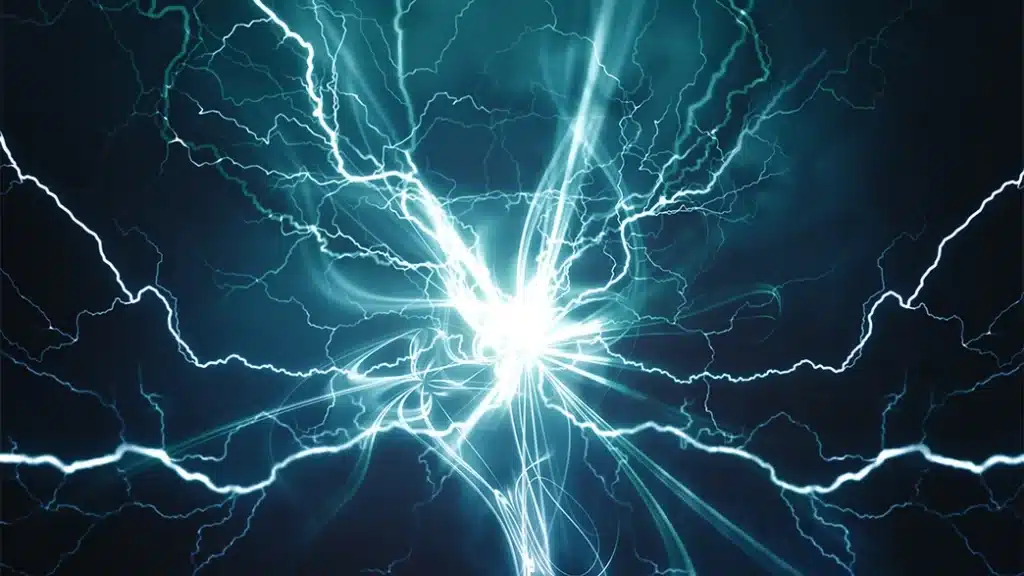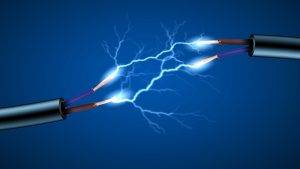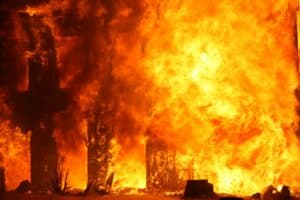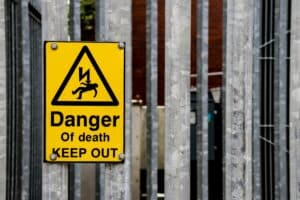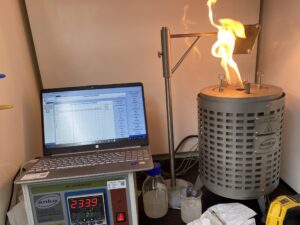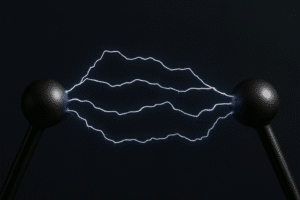We also offer
What Is An Electrostatic Hazard?
An electrostatic hazard arises when a static charge builds up and discharges with enough energy to ignite a flammable atmosphere. This discharge—called an electrostatic ignition source—can happen when two materials (liquids or solids) come into contact and then separate, generating and accumulating static electricity.
By itself, static charge is not dangerous. It becomes hazardous when:
-
The charge accumulates to a high level
-
The resulting discharge is strong enough to ignite gases, vapors, or dust
-
A flammable atmosphere is present
For a hazardous electrostatic discharge to occur, five conditions must be met:
-
A flammable atmosphere (gas, vapor, mist, or dust) is present
-
A process generates static charge
-
The charge accumulates
-
The charge exceeds the breakdown strength of the surrounding atmosphere
-
The discharge is energetic enough to cause ignition
To prevent this, conductive plant components—like metal pipes, vessels, and containers—must be grounded. If resistance to ground exceeds 10 ohms, a direct ground connection is required. Grounding systems should be checked regularly, and their purpose understood by both operators and maintenance staff.
Understanding Static Electricity: Generation, Accumulation, and Discharge
Charge Generation
Static charge is generated when two different materials come into contact. Electrons transfer between them, and when the materials are separated, one may retain a positive charge and the other a negative one—especially if either is an insulator.
Charge Accumulation
Charges build up when they are generated faster than they can dissipate. Materials are grouped based on volume resistivity:
-
Low resistivity powders (𝜌 ≤ 1 MΩ·m): Can still retain charge, even in contact with grounded material
-
Medium resistivity powders (1 MΩ·m < 𝜌 ≤ 10 GΩ·m)
-
High resistivity powders (𝜌 > 10 GΩ·m): More prone to accumulation
Electrostatic Discharge (ESD)
If enough charge accumulates, it can result in an electrostatic discharge. As two charged objects approach, the electric field intensifies. Once it exceeds the breakdown strength of air, a spark can occur—potentially igniting nearby flammable materials.
Risks Associated with Static Electricity
-
Electric shock to personnel
-
Fires or explosions from igniting flammable atmospheres
-
Production disturbances (e.g., in paper, plastic, powder handling)
-
Damage to electronics from electrostatic discharge
-
Wear or failure of mechanical components, like bearings
Electrostatic Hazard Assessment (EHA)
An Electrostatic Hazard Assessment (EHA) evaluates risks related to static electricity in facilities handling combustible materials. It helps prevent ignition incidents through a structured review of:
1. Identification of Static Sources
Determine where and how static charges are generated—often during material transfer or personnel movement.
2. Material Properties
Analyze how materials interact with static charge and whether they’re flammable or combustible.
3. Environmental Conditions
Review factors like humidity and temperature that affect charge generation or dissipation.
4. Equipment & Infrastructure
Check that all conductive parts are properly grounded and bonded to safely release static charges.
5. Work Practices
Assess operational procedures that might promote charge build-up or poor dissipation.
6. Risk Evaluation
Determine the likelihood of ignition and the potential consequences if it occurs.
7. Control Measures
Implement solutions like grounding, antistatic devices, or process modifications to minimize risks.
8. Training & Awareness
Educate employees on static hazards, grounding systems, and emergency procedures.
9. Documentation & Compliance
Keep thorough records and ensure your facility meets standards like NFPA, OSHA, or IEC.
10. Ongoing Monitoring
Review and update your assessment regularly as equipment, materials, or processes change.
Why perform electrostatic hazard assessment
Static electricity is a common ignition source in industries such as chemicals, pharmaceuticals, and petrochemicals. Without proper controls, it can cause fires, explosions, and costly damage.
By conducting an EHA, you can:
-
Identify and control static generation and accumulation points
-
Evaluate the effectiveness of grounding and bonding systems
-
Ensure compliance with industry safety standards
-
Protect your people, assets, and operations from static-induced incidents
Our Electrostatic Hazard Assessment
Static electricity can pose serious ignition hazards in industrial environments, especially where flammable gases, vapors, or dusts are present. Prime Process Safety Center offers a comprehensive Electrostatic Hazard Assessment (EHA) to help you identify, evaluate, and control these risks.
What Our Assessment Includes
Our EHA process involves a thorough on-site review and technical analysis. We will:
-
Visit your facility to inspect current static hazard control measures and identify gaps.
-
Identify flammable atmospheres and determine the minimum ignition energy (MIE) required to ignite them. For powders, this involves testing material samples.
-
Pinpoint charge generation and accumulation points by reviewing processes, substances handled, and operating conditions.
-
Evaluate potential discharge energy and whether it could ignite the flammable atmosphere.
-
Assess the effectiveness of your existing static controls, such as grounding and bonding systems.
-
Recommend additional safety measures, including alternatives or improvements to current controls.
-
Support implementation of new safety strategies to reduce static ignition risks, including help with design, testing, and employee training.
Why Choose Prime Process Safety Center
At Prime Process Safety Center, we bring deep expertise and a practical approach to managing electrostatic hazards. Our team specializes in static electricity risk control, with experience across chemical, pharmaceutical, and dust-handling industries. We tailor each assessment to your specific operations, ensuring relevant and effective recommendations.
Using advanced diagnostic tools and modeling systems, we accurately measure static charge generation, accumulation, and discharge potential. Our approach doesn’t stop at identifying risks—we also provide actionable solutions, from improved grounding and bonding systems to process adjustments.
We help ensure full compliance with applicable regulations and standards, including those from OSHA, NFPA, and IEC. Beyond compliance, we offer employee training programs to build awareness of electrostatic hazards and safe practices.
Our support continues after the assessment with ongoing consultation and follow-up, helping you maintain long-term improvements. We also deliver detailed reports with clear findings and practical steps for implementation.
Finally, our ISO accredited Houston-based laboratory supports your assessment with accurate, defensible testing data and conductivity measurements using industry-standard methods.
FAQ
1. What is Electrostatic Hazard Assessment?
It's an evaluation process to identify and assess risks associated with electrostatic charges in industrial environments, which can lead to fires, explosions, or other safety hazards.
2. Why is Electrostatic Hazard Assessment important in industrial settings?
It's crucial for preventing accidents caused by static electricity, particularly in industries handling flammable materials, where electrostatic discharge can ignite vapors, dust, or gases.
3. What industries commonly require Electrostatic Hazard Assessments?
Industries that handle flammable liquids, gases, powders, or solvents, such as chemical manufacturing, pharmaceuticals, petrochemicals, and food processing, typically require these assessments.
4. How is an Electrostatic Hazard Assessment conducted?
It involves measuring and evaluating static charge generation and accumulation, identifying potential ignition sources, and assessing the effectiveness of existing grounding and bonding systems.
5. What are the common sources of electrostatic hazards in industries?
Common sources include the flow of liquids or powders through pipes or chutes, the mixing of materials, and the friction or separation of materials in process operations.
6. What are grounding and bonding, and why are they important?
Grounding and bonding are techniques used to prevent the accumulation of static electricity. Grounding ensures that equipment is at the same electrical potential as the earth, while bonding equalizes electrical potentials between different pieces of equipment.
7. Who should perform Hazardous Area Classification?
Qualified professionals with expertise in process safety and knowledge of applicable standards should conduct these classifications.
8. What factors are considered during Hazardous Area Classification?
Factors include the type of hazardous materials present, their physical and chemical properties, operational processes, environmental conditions, and facility layout.
9. How does Hazardous Area Classification impact equipment selection?
It determines the type of explosion-proof or intrinsically safe equipment that should be used in different areas to prevent ignition of hazardous atmospheres.
10. Is Hazardous Area Classification a one-time requirement?
No, it should be reviewed and updated regularly, especially when there are changes in processes, materials, or facility layout, to ensure ongoing safety compliance.
11. What are some Potential Ignition Sources and Controls to be Considered in Hazardous Area Classification?
- Flames;
- Direct-fired space and process heating;
- Use of cigarettes/matches etc;
- Cutting and welding flames;
- Hot surfaces;
- Heated process vessels such as dryers and furnaces;
- Hot process vessels;
- Space heating equipment;
- Mechanical machinery;
- Electrical equipment and lights
- Spontaneous heating;
- Friction heating or sparks;
- Impact sparks;
- Sparks from electrical equipment;
- Stray currents from electrical equipment
- Electrostatic discharge sparks:
- Lightning strikes.
- Electromagnetic radiation of different wavelengths
12. In what way can ignition sources effectively controlled in all hazardous areas ?
- Using electrical equipment and instrumentation classified for the area in which it is located. New mechanical equipment will need to be selected in the same way.
- Grounding of all plant/ equipment.
- Elimination of surfaces above auto-ignition temperatures of flammable materials being handled/stored
- Provision of lightning protection
- Correct selection of vehicles/internal combustion engines that have to work in the zoned areas (see Technical Measures Document on Permit to Work Systems);
- Correct selection of equipment to avoid high intensity electromagnetic radiation sources, e.g. limitations on the power input to fibre optic systems, avoidance of high intensity lasers or sources of infrared radiation
- Prohibition of smoking/use of matches/lighters
- Controls over the use of normal vehicles
- Controls over activities that create intermittent hazardous areas, e.g. tanker loading/unloading
- Control of maintenance activities that may cause sparks/hot surfaces/naked flames through a Permit to Work System
13. What are some best practices for hazardous area classification?
- Follow established engineering practices such as NFPA, API, NEC, IEC and PIP etc.
- Ensure that hazardous area requirements are established before purchasing equipment.
- Ensure that hazardous area classification layouts reflect the current status of the facility.
- Review and update layouts before each modification.
- Ensure that the addition of new equipment does not impact existing equipment / facility and if so, take corrective action.
- Ensure that the area classification "cloud does not encroach roads, walkways, occupied buildings, welding / fabrication yards etc.
- Perform a thorough review when introducing new sources of release in an existing facility.
- Ensure equipment installed in the classified area is rated for service conditions.
- Follow the manufacturer’s installation manual, applicable codes and standards.
- Maintain proper documentation.
14. What are some precautions to be taken in hazardous areas?
Precautions include compliance with classifications (according to NEC), training and awareness programs, prevention of ignition sources, regular maintenance and inspection, proper ventilation, use of appropriate Personal Protective Equipment (PPE), and implementation of an emergency response plan and permit-to-work system.
15. What main safety measures to take for Class I, Class II, and Class III locations?
Safety measures vary for each class. For Class I locations, use explosion-proof equipment and proper ventilation to handle flammable gases or vapors. Class II locations require dust-tight equipment and dust control to manage combustible dust hazards. In Class III locations, protect against ignitable fibers with proper enclosures and handling protocols.
16. What is explosion-proof Protection and intrinsically safe protection?
Explosion-proof protection is a type of protection that involves using an enclosure capable of withstanding an explosive gas or vapor within it. The enclosure also prevents the ignition of an explosive gas or vapor surrounding it. This type of protection operates at an external temperature that ensures the surrounding explosive atmosphere will not be ignited.
Intrinsically safe protection ensures that electrical equipment, under normal or abnormal conditions, is incapable of releasing sufficient electrical or thermal energy to cause ignition of a specific hazardous atmospheric mixture in its most easily ignitable concentration.


